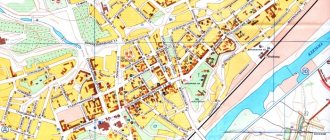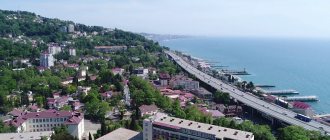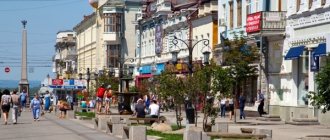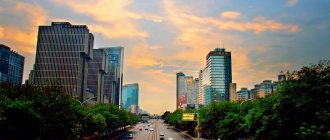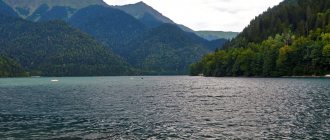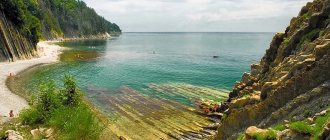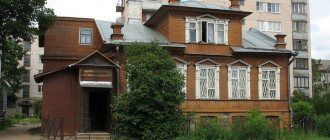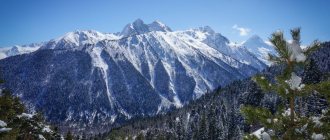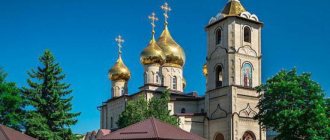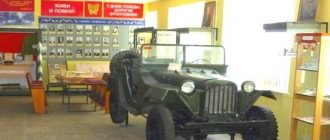Trinity Church
Trinity Church (1913-1916) is a former Old Believer church in Vladimir. The popular name is the Red Church. Now it is one of the branches of the Vladimir-Suzdal Museum-Reserve. Here is the Crystal Museum (Exhibition “Crystal. Lacquer miniatures. Embroidery.”
- Address: Vladimir, st. Dvoryanskaya, 2
- Entrance ticket cost: 150 rubles. adult, 75 rub. preferential.
- Opening hours: from 11.00 to 19.00.
For several centuries, Vladimir was first the actual and then the nominal capital of Rus'.
2. The city of Vladimir is one of the oldest settlements. Scientists claim that the first human settlements in these places appeared around the 1st century AD. In particular, on the territory of modern Vladimir at that time there was a settlement of one of the local Finno-Ugric tribes. Later, in the 9th-10th centuries, Smolensk Krivichi and Novgorod Slovenes appeared there.
3. Prince Vladimir Monomakh founded the city named after him around 1100. According to another widespread version, the city is much older, and was founded back in 990.
4. Vladimir is one of the most popular cities among tourists visiting the European part of Russia.
5.Vladimir is officially included in the list of cities of the Golden Ring of Russia. It is one of the most visited Russian cities by foreign tourists.
6. In Vladimir, three architectural monuments built before the Mongol-Tatar conquest have been preserved: the Golden Gate, the Assumption and Dmitrievsky Cathedrals.
7. Once upon a time it was possible to get to Vladimir through one of the 7 gates, but only one of them has survived to this day - the Golden.
GOLDEN GATE IN VLADIMIR
8. Initially, the gates of the Golden Gate, which were actually covered with pure gold, were removed and taken away by the Mongols in an unknown direction. The future fate of the gate still remains a mystery.
9. The famous Golden Gate in Vladimir performed not only a protective function, but also served as a triumphal arch.
10. Now the Golden Gate attracts tourists from all over the world. In their upper part there is a Museum of Military Equipment.
BUILDING OF THE CITY DUMA OF THE CITY OF VLADIMIR
11. In total, there are 239 state-protected buildings in the city - most of them were built in the 18th-19th centuries.
12.Many foreign tourists come here to personally admire the ancient temples and kremlins.
13. More than 350 thousand people live here, which exceeds the population of the entire Iceland.
14. In 1299, the see of the Russian metropolitan was moved from Kyiv to Vladimir.
15. In the past, this city was sometimes called Vladimir-Zalessky or Vladimir-on-Klyazma.
AT THE CRYSTAL MUSEUM
16. The city is known for its unusual museums, among which, along with traditional ones, there are several unusual ones. These include museums of spoons, optical illusions, crystal, gingerbread and others.
17. During the Great Patriotic War, 18 military hospitals operated in Vladimir. As a result, the city was a strategically important facility where tens of thousands of Soviet soldiers were treated.
DMITRIEVSKY CATHEDRAL IN VLADIMIR
18. In Vladimir, a magnificent example of pre-Mongol architecture has been preserved - St. Demetrius Cathedral.
19. Since 2013, Vladimir has been the center of the metropolitanate of the Russian Orthodox Church.
20. During the Great Patriotic War, 18 hospitals were evacuated to Vladimir, which made it one of the most important cities in the rear. Vladimir residents donated about 40 thousand liters of blood to save wounded soldiers.
ASSUMPTION CATHEDRAL
21. The pride of Vladimir is the Assumption Cathedral, which served as a model for the construction of the temple of the same name in the Moscow Kremlin. In it you can see several frescoes by Andrei Rublev.
22. There is a legend according to which Empress Catherine II, during one of her visits to Vladimir, was unable to enter the city through the Golden Gate - either the empress was afraid to pass under the arch, which was in a deplorable state, or the five-meter width of the gate was not enough for her carriage.
23. The Empress ordered the restoration of the famous arch and the demolition of parts of the fortress rampart that came close to the Golden Gate, so that from now on anyone could easily get into Vladimir.
24. The gates of the Golden Gate were removed and taken away in an unknown direction by the Mongol-Tatar invaders. According to one version, the gate was sunk in the Klyazma River, and since then dozens of unsuccessful attempts have been made to find this treasure.
25. Japanese experts offered to clean the river bottom at their own expense, but on the condition that all finds would go to them. The Soviet authorities refused this proposal.
TRINITY CHURCH
26. Trinity Church in Vladimir, where the exhibition of the Crystal Museum is now located, is one of the main Old Believers churches in the European part of Russia.
27. Local residents call the bypass road around Vladimir, which is part of the M-7 highway, “Beijing”. It is believed that the highway was supposed to be completed to Beijing, but then the friendship between the USSR and China weakened, and the project remained on paper.
28. In the 13th century, after the death of the Vladimir prince Alexander Nevsky, a struggle for the Vladimir throne broke out, which lasted about a hundred years.
29. The appearance of the historical part of Vladimir was damaged due to the construction of the Moscow-Nizhny Novgorod railway. The constructed track facilities did not fit well with the architectural ensemble of the southern “microdistricts” and disfigured their magnificent panorama.
30. During the Soviet era, the city of Vladimir lost many churches, and most of the remaining ones were closed to believers. They were returned to the RCP only in recent years.
31. There are a lot of parks and forests in Vladimir, so it is literally surrounded by greenery.
32. In the pre-war decades, the city underwent accelerated industrialization with the goal of transforming it into a large industrial center, and in 1944, Vladimir, which received hundreds of thousands of evacuees from the western regions of the USSR, became the center of the region of the same name.
33. In the 1950s, several universities and the Torpedo stadium were opened, large enterprises in the metalworking, mechanical engineering, electrical, chemical, instrument-making and light industries were created.
34. In the spring of 1971, the Moscow-Vladimir electric train made its first flight, and 5 years later a new railway station opened in the city. This, as well as its inclusion in the route of the Golden Ring of Russia and the construction of the Zarya, Klyazma and other hotel complexes contributed to the development of tourism.
35. In the 1980s, housing construction was carried out at an active pace in Vladimir.
VLADIMIR CENTRAL
36. Founded back in the 18th century, the Vladimir Central is a prison for especially dangerous criminals, one of the most reliable in the world, since throughout history no one has managed to escape from it. Now there is a local pre-trial detention center there.
37. The weather in the city is cloudy most of the year; clear, sunny days account for only 1/3 of the year.
38.During the year, the air temperature in the city ranges from -40 to +37 degrees.
39. In the 19th century, the city of Vladimir was rebuilt. Along with ancient monuments, several buildings in the style of classical architecture appeared (the buildings of the Noble Assembly, the men's gymnasium, and others).
40.In addition, a new cathedral bell tower and arcade of shopping arcades were built. Fortunately, the subsequent industrial development of the Russian Empire almost did not affect Vladimir.
41. At the same time, the city authorities did not value ancient buildings, so many of them were irretrievably lost. This was done for the purpose of building apartment buildings, which were located mainly along Main Street.
42. In the early 70s of the last century in the USSR, Vladimir was awarded the honorary award of the Red Banner of Labor for his contribution to the development of industry.
43. Vladimir has its own “haunted house” - a building built at the end of the 18th century, which now houses an exhibition hall. Due to an error in calculations when creating the project, voids formed in the walls of the house, and the stone building began to “talk.”
44.On City Day in Vladimir, a traditional procession “The Three Capitals of Great Russia” is held - its participants walk in historical costumes (and some even ride horses) from the Golden Gate to Cathedral Square.
45. On the territory of Vladimir there are more than two hundred cultural and historical monuments. Among them there are several unique architectural structures included in the lists of the cultural heritage of mankind according to UNESCO.
photo from the Internet
House-Museum of the Stoletov Brothers
The Stoletov Brothers House-Museum is another branch of the Vladimir-Suzdal Museum-Reserve. The Stoletov brothers were born in Vladimir. Nikolai Grigorievich Stoletov (1831-1912) - Russian military leader, commander of the Bulgarian militia in the Russian-Turkish war of 1877-78. Alexander Grigorievich Stoletov (1839-1896) - Russian physicist, professor at Moscow University. The museum is dedicated to the life of the Stoletov family and specifically the two brothers.
- Address: Vladimir, st. Vorovskogo, 16
- Telephone
- Opening hours (from 04/28/2018 to 06/30/2018 and from 09/01/2018 to 09/30/2018): Tue.-Thurs.: from 10.00 to 16.00, Fri.-Sun: from 10.00 to 18.00. Mon. - day off.
- Entrance ticket cost: 100 rubles. adult, 50 rub. preferential.
- It's not very interesting without a tour. Book a tour by phone in advance! The telephone number of the unified dispatch service for excursion services is: + 7 (4922) 601-001 – the call is free.
Life in spite of: how the city of Vladimir has changed in 2022
The 2022 pandemic has revolutionized urbanism. Just a couple of years ago, life in cities went on as usual, but the coronavirus, which everyone will obviously have to live with for a long time, forced city planners to reconsider their approaches to work. The world has been gripped by a general reflection on an environmentally friendly, safe and convenient infrastructure future. Taking care of urban spaces is no longer a first world problem; it is now a function as important for every state as, for example, education or medicine.
London is spending millions of pounds on cycling and walking infrastructure. Paris is getting rid of half of its outdoor parking lots. Chelyabinsk has adopted the concept of 15-minute accessibility, when everything essential for a person’s life is at hand. Japan and other countries plan to abandon internal combustion engines in 10-15 years and switch all transport to electricity.
The boulevard on Sokolova-Sokolenka Street is the main disappointment of the city improvement programVladimir still remains aloof from global trends. Globally, nothing has changed in the city: pedestrian barriers are still appearing along the streets, public spaces are being updated according to the patterns of the early 20th century, traffic jams are being combated by expanding roads instead of developing public transport and means of individual mobility - bicycles and scooters.
Fence on Bolshaya Moskovskaya street
Over the past 10 years, the administrative center of the Vladimir region has gone through an amazing journey from a typical provincial capital to an attractive small city and back. At some point, about five or six years ago, Vladimir was deservedly set as an example: the streets became cleaner, the monuments of white stone architecture became whiter, and even the sun seemed to begin to shine brighter. But while the city admired itself, others worked hard. By the end of 2022, Vladimir was left far behind Belgorod, where they staged a real transport revolution; Almetyevsk, which became the cycling capital of Russia; Tula with its fantastic embankment near the walls of the local Kremlin; and so on.
The pedestrian zone on Georgievskaya Street, opened six years ago, has not undergone any changes since then.
Not to say that cities suddenly became richer: municipalities in modern Russia are still the most powerless administrative units with a bunch of social obligations and the absence of minimum development budgets. First of all, the thinking changed: local administrations began to learn, invite specialists from abroad, take on the experience of others, and realized that local identity and dissimilarity are attractive.
Children's playground in Dobroselsky Park. Similar play areas, only on a smaller scale, exist in almost every city yard
Against this background, the paradoxical nature of Vladimir urbanism becomes even more pronounced. Vladimir does not use the trump cards that other cities do not have - from smart professionals to an advantageous geographical location, gradually losing its face and aesthetics of a provincial city with a 1000-year history.
One of the main surprises of 2022 is graffiti by artist Mishkin
Everything good last year happened more in spite of than thanks to it. Vladimir is completely unsuited for bicycles, but bike sharing is appearing in the city. Soviet buildings are becoming overgrown with ventilated facades, and nearby street artists are turning faceless sewer exits into elements of computer games from the 90s. Public discussions of improvement projects take place at an inconvenient time for most, but citizens will still learn in practice what participatory design is.
Bike sharing Lucky Bike
Unfortunately, there are more negative examples. There is objectively not enough money to develop the passenger transportation market, but the Vladimir mayor’s office stubbornly ignores federal co-financing programs. Officials say that Vladimir is a city, first of all, for people, and then two people are hit on the same pedestrian crossing, several days apart. Residents ask for a modern, eco-friendly park for a quiet holiday - and it is immediately filled with sports grounds.
Public transport in Vladimir needs reform, although the mayor’s office considers its work optimal
Paradoxes don't come out of nowhere. They naturally appear due to the lack of a clear goal and vision of what the city will be like in 10, 20, 30 years. Vladimir does not have a full-fledged strategy that would determine the place of the capital of the Vladimir region in the future. The city hall is too busy with current problems to look for answers, the townspeople are too busy surviving to form a full-fledged community, and the city as a space where the interests of both sides intersect is left on its own. A way out of this vicious circle remains to be found.
Model of the future park on Mira Street behind DDYUT
Church of the Holy Rosary in Vladimir
The church, made in a pseudo-Gothic style, is truly a decoration of ancient Vladimir. Among similar religious buildings, the church stands out for its specific architecture with a high tower and multiple structural details of the facade.
The red brick building was named after the holiday of the same name, which is celebrated by Catholics on October 7. In 1993, it was decided to return the church to the Catholic Church.
11
Temple of St. George the Victorious
In the very center of the ancient Russian city, the majestic and unique temple of the Holy Great Martyr George the Victorious is comfortably located. Historians and antiquity lovers will appreciate this part of the city.
In front of the church, the ancient pavement of the street has been preserved, and the building itself, built back in 1157, is simply filled with the ancient charm of Russian architecture. In the old days, there was a monastery attached to the temple.
The church survived the tragic events of Russian history and today delights the eyes of parishioners and tourists with its monumentality and splendor.
6
Botanical Garden
The exact name of this most beautiful and unique object of Vladimir is “Patriarchal Garden”.
The multi-tiered park is located on the slopes of an ancient hill. Interesting park. First of all, its amazing landscape. In addition, unique and exotic varieties of trees and flowers are collected here.
Guests of the city and residents of Vladimir can stroll along the shady alleys, as well as relax on benches in the picturesque landscapes of the garden.
9
Mother of God Nativity Monastery
Founded at the end of the 12th century by Grand Duke Vsevolod Yuryevich, the monastery for a long period, even before the erection of the Trinity-Sergius Lavra, was the center of the monastic and spiritual life of Ancient Rus'. For some time, the remains of Prince Alexander Nevsky rested in the monastery. Until 1991, the monastery housed departments of the Cheka, NKVD, KGB and a pre-trial detention center.
Mother of God Nativity Monastery
The monastery is the site of mass graves from the time of Stalinist repressions. After 1991, a gradual revival of the monastery began. Today, religious services are held here, and the area is open to visitors.
- Address: st. Bolshaya Moskovskaya, 68.
- Phone for information: +7(4922)-32-67-10.
Dormition Princess Monastery
The convent was founded in the 13th century by the wife of Grand Duke Vsevolod Yuryevich. A few years after the construction of the monastery, Princess Maria, being seriously ill, took monastic vows under the name Martha.
Dormition Princess Monastery
The temple failed to preserve its original appearance; after the invasion of the Mongol-Tatars, the monastery was devastated, burned several times and was in complete desolation for a long time. The revival of the monastery began in the 16th century; today visitors can see the buildings of those times. The temple ceased to function for several decades during the Soviet period. In the 90s, the monastery resumed its work, providing a haven for several novices.
- Address: Knyaginin Monastery, 37 A.
- Phone for information: +7(4922)-32-67-73.
Assumption Cathedral
This amazing monument of Russian architecture of the pre-Mongol period can certainly be considered the hallmark of Vladimir. Built in the 12th century, the temple became a model for the construction of cathedrals in later times.
Construction of the cathedral began in 1168 by Andrei Bogolyubsky, but the cathedral was already painted in the time of Vsevolod. The real pearl of the ancient Russian temple are the original frescoes by Andrei Rublev. Thousands of pilgrims and tourists come to Vladimir to see this wonderful monument of architecture and wall painting.
3
Cathedral Square
The appearance of the most beautiful Vladimir Square is formed by monuments and ancient buildings of Bolshaya Moskovskaya Street.
In the very center of the square you will find a beautiful monument, which was erected in honor of the 850th anniversary of the city. On three sides of the pyramid, which goes up into the sky, there are figures of a warrior, a worker and an architect.
In 1995, the square was decorated with a magnificent monument to the Russian icon painter and artist Andrei Rublev.
We recommend watching: TOP 15 most beautiful squares in Europe.
7
Vladimir Central
Vladimir Central is one of the most famous prisons in Russia. It gained wide popularity, including thanks to the hit song of the same name performed by Russian singer Mikhail Krug. The institution, founded by decree of Catherine II in 1783, was intended to contain especially dangerous criminals. At various times, political prisoners, spies, saboteurs, Mensheviks, Trotskyists, and members of anti-Soviet organizations stayed within its walls.
Vladimir Central
Currently, there is a museum on the territory of the Vladimir Central, its exhibition is dedicated to the history of the prison and the life of famous prisoners there, among whom were Joseph Stalin’s son Vasily, Lydia Ruslanova and her husband, pre-revolutionary State Duma deputy Shulgin, German field marshal Scherner, an Israeli minister and a Soviet dissident Sharansky.
- Address: st. Bolshaya Nizhegorodskaya 67.
- Opening hours: daily from 8:00 to 17:00 with a break from 12:00 to 13:00.
- Phone for information: +7(4922)-32-60-67.
Dmitrievsky Cathedral
Another masterpiece of Russian architecture was erected in Vladimir by Prince Vsevolod the Big Nest. And the prince dedicated this magnificent temple to the martyr Dmitry of Thessalonica.
The Principality of Vladimir was experiencing its heyday, and the temple was supposed to emphasize the power and strength of Vladimir. But its relatively small size is explained by the fact that it was a family, so to speak, house church of a large princely family.
Among similar religious buildings, Dmitrievsky Cathedral stands out for its unique and inimitable stone carvings.
Nikitskaya Church
Erected in the second half of the 18th century by the merchant Semyon Lazarev, the Nikitskaya Church is considered an atypical religious building. The three-story white and green temple, made with elements of the Baroque style, is more reminiscent of a merchant mansion.
Nikitskaya Church
The cathedral was open for worship until 1938, then it became the location of a restoration workshop, and since 2015 it has been transferred to the Vladimir diocese. Divine services have been resumed in the church, and a Sunday school is operating.
- Address: st. Knyagininskaya, 8.
- Opening hours: daily from 8:30 to 18:00.
- Phone for information: +7(910)-183-82-02.
Water tower
It turns out that an engineering structure can be a masterpiece of architectural construction.
Built in 1912, the tower lost its functional purpose in the 50s of the 20th century, and now the building houses exhibitions of the Old Vladimir Museum.
Standing on the observation deck of the Vladimir water tower, you can enjoy beautiful views of the city and the banks of the Klyazma. According to the editors of most-beauty.ru, this is one of the most beautiful water towers in the world.
8
